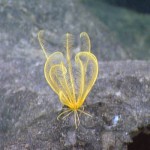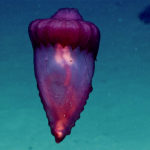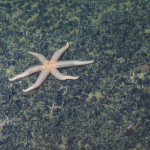A report from Dr. M while he is at sea in the northeast Pacific. You can also follow the expedition here.
Monday was consumed with our second dive on the north end of Coaxial (46.5191126, -129.588406) along the Juan de Fuca Ridge. Two and a half kilometers down we slowly make our way across lava sheet flows. A fine dusting of sediment covering these smooth sheets was wisped away as the ROV passed overhead. Brittle stars, the “pigeons” of the deep-sea, ranged in size from a penny to a dinner plate covered the landscape. Intermittently, we observed sea cucumbers camouflaged by covering themselves in broken shell pieces. In this case, the armor plating is old pteropod shells from long-dead individuals that dwelled in the water column above. The highlights are lollipop shaped sponges, spheres of spicules on 10 centimeter stalks, affectionately named by us as an “sponge-on-a-stick”. A unknown species of a soft coral also captured our attention. By the end of the dive we have visited two flows of unknown age and another dated between 1982-1991.
Tuesday we sent the ROV to a caldera on Axial Seamount (45.940745, -129.983788) at 1500m. This once was an eight by three kilometer underwater molten lake filled by multiple flows. As these individual flows hit barriers, lava began to pool and rise. When the flow managed to rupture or overcome a barrier, the pooled lava would subside. This left behind an elevated surface layer, now cooled and hardened, marking the once elevated lava pool. Over time, this surface layer has fallen and cracked revealing empty voids below it. In some areas, lava pillars, which are formed by lava rapidly cooled from water venting out, hold up this old surface layer like a ceiling. Lava bridges, arches, caverns, ceilings, pits, fissures, and voids are the building blocks of this landscape, reminiscent more of fire-bombed cathedrals than the deep-sea floor. Sea stars were the rulers of this charred, but often spiritual, landscape, overseen by hovering rattails like so many zeppelins. As we approach, brittle stars moved away from the intense lights utilizing four of their five legs to become temporary quadrupeds. Others displayed a ratcheting behavior, previously unknown among our group and possible to science. They turned their central disc first clockwise while coiling their arms and then repeated counterclockwise. This produced an effect that both propels them forward rapidly, but also produced an erratic trajectory that may throw off a nearby predator or a Volkswagen sized ROV.





